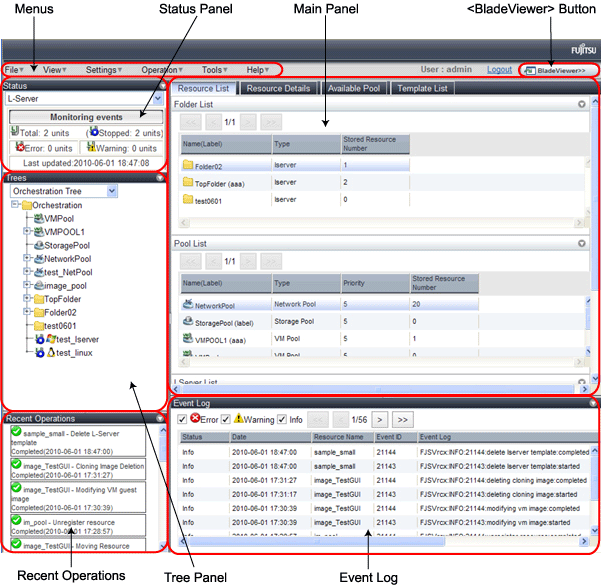This section explains how the RC console is organized.
Figure 3.1 RC Console

Operations can be performed either from the menu bar or popup menus.
The menus provided on the menu bar of the RC console in addition to the ServerView Resource Coordinator VE menus are listed in the table below.
For details regarding the menus not listed below, refer to the screen explanation in the "ServerView Resource Coordinator VE Setup Guide".
Menu bar | Menu | Submenu | Function |
|---|---|---|---|
File | L-Server template | Import | Imports an L-Server template. |
Export | Exports an L-Server template. | ||
Settings | Pool | Register | Registers a resource in the selected resource pool. |
Deregister | Deregisters the selected resource from a resource pool. | ||
Create | Folder | Creates a resource folder in the server tree or orchestration tree. | |
Pool | Creates a resource pool in the orchestration tree. | ||
L-Server | Creates an L-Server. | ||
Network Resource | Creates a network resource. | ||
Move to another folder | - | Moves a resource pool, resource folder, or a resource to another resource folder. | |
Move to another pool | - | Moves a resource to another resource pool. | |
Operations | Snapshot | Collect | Collects a snapshot of the L-Server. |
Restore | Restores a snapshot to the L-Server. | ||
Deleting a Snapshot | Deletes a snapshot. |
The Status Panel displays the status of managed servers. The status of both physical servers and L-Servers can be displayed. The properties displayed for physical servers and L-Servers can be switched from the drop-down menu.
Only the L-Server status is displayed for the following users:
Users with a role that only allows use of L-Servers
Users with restricted access
If a warning or error event occurs on a managed server, the status monitoring area starts to blink.
If you click the blinking area, the server's information is displayed on the main panel.
For details of the status, refer to the information about status in the "ServerView Resource Coordinator VE Setup Guide".
Resource Orchestrator displays the orchestration tree and storage tree in addition to the trees provided by ServerView Resource Coordinator VE. If resource folders have been created in the server tree, these resource folders are also displayed.
Only the orchestration tree is displayed for the following users:
Users with a role that only allows use of L-Servers
Users with restricted access
The resources displayed are restricted according to the access rights of the logged in user.
Manages and operates L-Servers and resource pools.
All resources authorized for access by the logged in user are displayed. The resources displayed differ depending on the role and access rights of the user.
The statuses of the following resources are shown in a tree view:
Resource folders and L-Servers
Resource pools and the resources registered in resource pools
The top-level resource folder of each tree is called the root folder. The standard tree consists of only the root folder.
The orchestration tree displays the following information:
Resource List
Displays information on resources related to the resource selected in the resource tree.
Resource Details
Displays detailed information for the resource selected in the resource tree. Additionally, external software can be opened.
Available Pools
A list of resource pools available for use is displayed.
Template List
A list of L-Server templates available for use is displayed.
Using an L-Server template, an L-Server can be created.
The server resource tree displays all chassis, servers, VM hosts, VM guests, and LAN switches managed in Resource Orchestrator, in a tree view.
The network resource tree displays all LAN switches other than LAN switch blades managed in Resource Orchestrator, in a tree view.
The storage resource tree displays all storage management software, storage units, RAID groups, LUNs, and virtual disks of VM guests managed in Resource Orchestrator, in a tree view.
Resources displayed in the server resource tree and network resource tree are represented by an icon and their resource name.
For details on icons and their resource names, refer to the "ServerView Resource Coordinator VE Setup Guide" for the screen explanation, and the "ServerView Resource Coordinator VE Operation Guide" for notes regarding resource status.
The Main Panel displays information on resources selected in the tree.
Displays the progress statuses and results of operations performed in Resource Orchestrator according to the user's scope of access.
The Event Log displays information on events that have occurred.
ServerView Resource Coordinator VE events are displayed in addition to Resource Orchestrator events.
It displays a log of events that have occurred on managed resources.
The resources displayed are restricted according to the role and scope of access of the user.
Opens the BladeViewer interface.
BladeViewer is a management interface specially designed for blade servers. It can only be used in conjunction with PRIMERGY BX servers registered as managed servers.